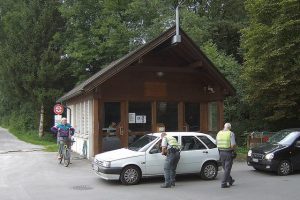Bearings
Border Crossings: Barriers or Points of Access?
By Robert Grove-Markwood
February 2015 Issue

From 1988 to 2012, I served as the pastor of a United Church of Christ congregation in the small city of Presque Isle, which is located in Aroostook County in northern Maine—just a few miles from the Canadian border. In the spring of 2001, I had been a member of the local Rotary Club for over a dozen years, and I was about to begin a term as club president. So one Saturday morning, a fellow Rotarian and I drove to Grand Falls (in New Brunswick, Canada) to attend a training event for new Rotary Club leaders. Neither of us was particularly excited to be out so early on a day when we could have been doing any number of more personally-appealing or necessary things.
Crossing the border near the small town of Limestone, we were expecting the routine questions: What’s your destination and reason for entering Canada? How long will you be in the country? Where do you live? May I see your ID? Do you have anything to declare?
But the questions that were asked of us that day were anything but routine—for me, at any rate. After we stopped at the checkpoint and handed the Border Agent our IDs, he departed from his script and asked, “Well, gentlemen, what’s your mission in life today?” I became the spokesperson, since the agent approached my side of the vehicle. I almost laughed, but decided to keep my answer simple and sober: “We’re traveling to Grand Falls for a Rotary meeting, and we’ll be returning this afternoon.”
Why did I almost burst into laughter? Partially out of surprise, I suppose: I was not expecting the novelty of the Agent’s riff on the customary border-crossing questions. But it was more than that. Deep down inside, I was struck by the irony of the situation. When that border agent asked me about my mission in life, he could not have known that I was in the second semester of a Doctor of Ministry program at Bangor Theological Seminary, and he could not have known that the entire D.Min program was designed to help me and the congregation that I was serving answer the very same question he had just posed: What is your mission?
Similarly, he could not have known that the course I was currently taking was called “Resources for Sustenance and Renewal of Ministry & Communities of Ministry”—or that this fact caused me to interpret his next question quite differently than most border-crossers. When he asked us, “What have you got with you?” I said out loud, “Nothing, just us” . . . but inside my D.Min-conditioned mind, I silently translated his question: “Do you have the tools, resources, insights, convictions, and commitment needed to accomplish this mission, once you figure out what you are supposed to be doing today?”
Even as I translated, it occurred to me that such questions might serve as invitations to think about baggage: the outdated assumptions, and limiting preconceptions that we—my D.Min. colleagues and I—might be bringing to the work of renewing our churches’ ministries.
As my Rotary Club colleague and I passed through the border gates and drove on toward Grand Falls, I chuckled, “That was weird,” and shared my reactions with my friend. I told him a little about the Doctor of Ministry program and its goals of congregational transformation and renewal. And then, turning back to our immediate context, I joked that what he and I probably “had with us” as Rotarians on that day was a sense of obligation and lukewarm enthusiasm.
On the surface, the joke reflected my anticipation of a boring, corporate-style training event. But underneath, it exposed a deeper concern: What if my punch line was too accurate? What if it perfectly described the current state of the ministry of our church in Presque Isle—for both me as pastor and the people? Collectively, all of us knew that we would need more than just a “sense of obligation and lukewarm enthusiasm” in order to tackle such big questions . . . and the prospect of doing so both thrilled us and made us nervous.
On that particular spring morning back in 2001, the significance of my border-crossing experience lay mostly in the questions that were asked, which I heard as surprising, divine promptings from an unexpected messenger. I also understood in those moments that nothing less than full-hearted commitment would allow me and my church to sufficiently live into the important questions we had discerned—about mission, about resources, about energy, about enthusiasm.
Thirteen years later, I find that things have become more complex. Even as I argue that embracing questions and fully committing are still critical, I am interested in the specific location of my long-ago epiphany—in the fact that it took place at a border crossing. Is there something about borders themselves that makes them thin places for new revelation?
In her review of Crossing Borders, Dissolving Boundaries, a collection of twelve essays edited by Hein Viljoen, Karina Magdalena explains:
Thresholds, borders, boundaries, frontiers, lines, bridges—they can function as barriers or points of access, and they can represent opportunities or risks. Inevitably accompanied by the concept of liminality, they are indispensable in our way of perceiving and categorising the world . . .
The “risk” to which Magdalena refers occurs when borders function only as barriers that seek to preserve and protect, especially from “the other.” All too often, such scenarios give rise to isolation, exclusion, xenophobia, mindless conformity, and the suppression and even punishment of difference.
 Magdalena’s “opportunities” arise when border zones are permeable or open. In his introduction to Crossing Borders, Dissolving Boundaries, editor Hein Viljoen observes that “borders serve to safeguard sovereignty and identity, but also put such ideas at risk by allowing people to meet and exchange goods, money, art, music, ideas, stories, and technology” (xii). In the process of crossing borders we may experience the challenges of physical and spiritual dislocation, while also discovering that we are opened up to new possibilities for ourselves and for others. At its best, border crossing promotes creativity, innovation, diversity, mutual understanding and acceptance.
Magdalena’s “opportunities” arise when border zones are permeable or open. In his introduction to Crossing Borders, Dissolving Boundaries, editor Hein Viljoen observes that “borders serve to safeguard sovereignty and identity, but also put such ideas at risk by allowing people to meet and exchange goods, money, art, music, ideas, stories, and technology” (xii). In the process of crossing borders we may experience the challenges of physical and spiritual dislocation, while also discovering that we are opened up to new possibilities for ourselves and for others. At its best, border crossing promotes creativity, innovation, diversity, mutual understanding and acceptance.
This dialectic of risk and opportunity has been evident on several fronts in the U.S in recent months. Collectively, we have witnessed the development of new narratives, debates, and confrontations about many controversial (and poignant!) border-related stories: waves of vulnerable children crossing into the United States without their parents; potential amnesty for undocumented immigrants; paranoia over the return of health care workers who treated Ebola victims in Africa; the apparent hacking of Sony Corporation’s computer servers; continuing conflict in Palestine and Israel; and millions of refugees fleeing war, poverty, natural disasters, and political oppression. While geo-political boundaries tend to dominate the ways in which we think about borders as barriers or access points, we must remain aware that boundaries also operate on symbolic and cultural levels. There, contested boundaries give rise to clashes over religious and political ideologies, debates over gender (and especially transgender) concerns, and questions about the need for assimilation versus the need to maintain cultural and ethnic identities.
We created The BTS Center’s BEARINGS blog to help you, our readers, navigate the risks and opportunities involved in crossing the many borders that permeate the landscape of 21st-century ministry. At a time when many of you may feel as though your faith communities and congregations are border-crossing points—for a mass emigration from the land of Church-As-We-Know-It to the adjoining, alien country of Not-Church-But-Maybe-Spiritual—we want to help you explore new ways of being (and ministering) in religious frontier lands. To that end, we are launching several new programs in the coming months.
Because I think border crossings are very much about navigating change, I want to highlight one of The BTS Center’s upcoming offerings. Our “Blinded by the Light” workshops will address the changing religious landscape by engaging the questions of (1) how to contend with what appear to be constantly-shifting borders and (2) how to preserve the best aspects of our spiritual traditions while also embracing future innovations . . . with more than lukewarm enthusiasm. Dr. Pam Shellberg, The BTS Center’s scholar-in-residence, will lead small groups of clergy and lay leaders in inquiry sessions, exploring the stories of Paul and Ananias, who made significant border crossings themselves. The stories will be explored for their wisdom in identifying not only the disruptions and discontinuities experienced in ministry today, but also the resources needed for reorientation, recovery, and response.
Beyond these goals, however, the workshops will address what Hein Viljoen identified as a central concern for border-crossers: namely, “defining a new self and new relations to the other”(xlv). Today’s ministry leaders possess amazing opportunities to transform the ways in which we think about religious border crossing . . . but only if we engage in deep, thoughtful reflection and conversation about the best ways to embody our faith in all the world, including the places of daily life, digital environments, and, yes, our churches.
Take a moment to imagine the invisible border that exists between your faith community and wider society. Now think of the act of crossing that border. What does that image conjure up for you? In your mind, which direction does the traffic flow? Does “border crossing” call upon you to brainstorm the best strategies for getting “outsiders” to pull the church doors open and come in? Or, conversely, does it call upon you to make an even greater effort: to push the heavy doors open and move across the sacred-secular border, out into the community that surrounds your ministry setting?
One long-ago spring morning, a Canadian border agent helped me re-imagine the key questions that shape my quest to be the best faith leader possible. It was such a strange experience. At border crossings and TSA checkpoints, I usually feel intimidated and anxious—even though I never have anything to hide. But that particular day, I felt opened up.
Recalling this experience, I wonder: How might ministry leaders be Border Agents of a new kind? Instead of being gatekeepers, who seek to filter or control access to spiritual-religious realms, maybe ministers could function as friendly-yet-inquisitive questioners who welcome people to new lands.
If that’s the case, how might we encourage spiritual travelers to open up and clarify their questions and their paths toward the goals of inclusion and justice? How might we journey with them as they re-imagine the borders and boundaries that have defined them and their relationships with others?
Here at The BTS Center, we’re ready to be your traveling companion. Let’s explore this frontier together.
Photo Credits:
"Borders / frontier" by Paolo Cuttitta, 2009. Licensed under Creative Commons CC BY 2.0 / Desaturated from original
"Rural Customs" by Kecko, 2007. Licensed under Creative Commons CC BY-ND 2.0.

